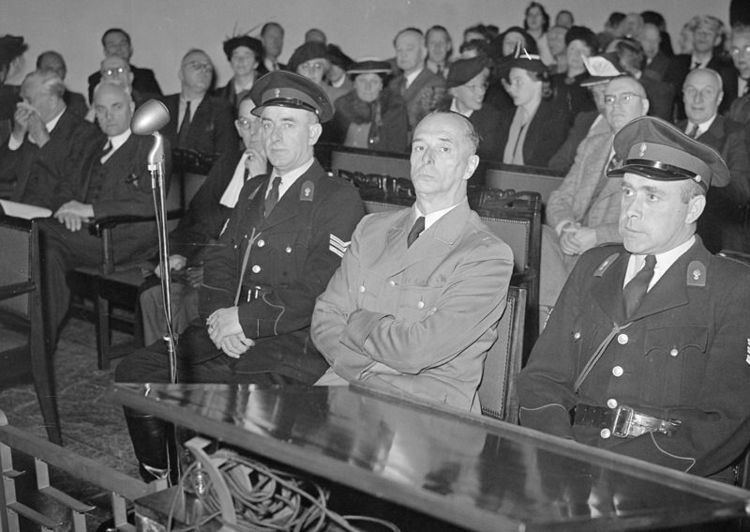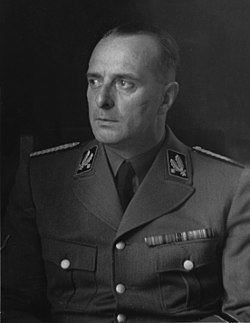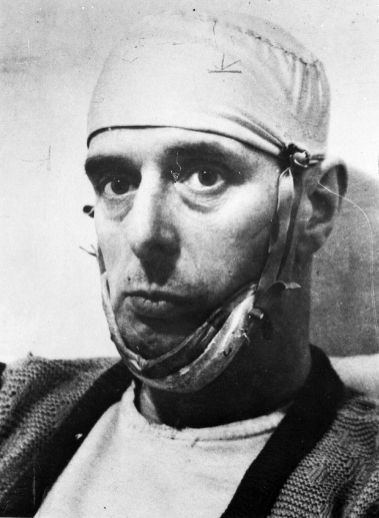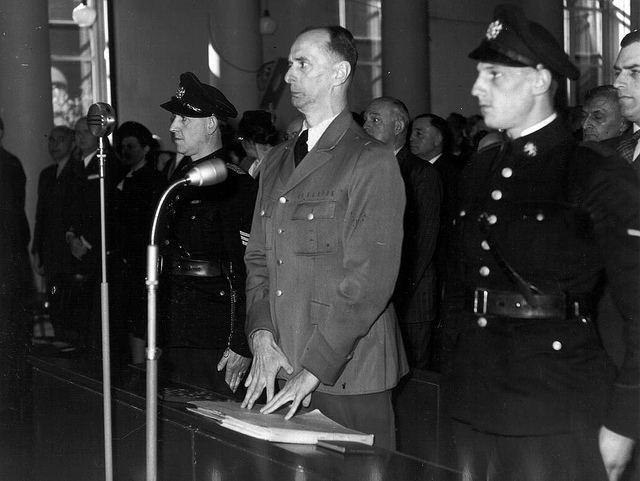Role Political leader Name Hanns Rauter | ||
 | ||
Years of service 1914-1919, 1921, 1927-1945 Rank SS-Obergruppenfuhrer and General of Police Battles/wars World War IWorld War II Died March 25, 1949, Scheveningen, Netherlands | ||
Trial of hanns albin rauter in the hague netherlands hd stock footage
Johann Baptist Albin Rauter (4 February 1895 – 24 March 1949) was a high-ranking Austrian-born Nazi war criminal. He was the highest SS and Police Leader in the occupied Netherlands and therefore the leading security and police officer there during the period of 1940–1945. He reported directly to the Nazi SS-chief, Heinrich Himmler, and in the second instance to the Nazi governor of the Netherlands, Arthur Seyss-Inquart. After World War II he was convicted in the Netherlands of crimes against humanity and executed by firing squad.
Contents
- Trial of hanns albin rauter in the hague netherlands hd stock footage
- Hanns albin rauter is tried for nazi war crimes in the hague netherlands hd stock footage
- Early life and career
- Actions in the occupied Netherlands
- After the war
- References

Hanns albin rauter is tried for nazi war crimes in the hague netherlands hd stock footage
Early life and career

Born in Klagenfurt, Rauter graduated from High school in 1912 and started training as an Engineer at the Graz University of Technology. At the outbreak of World War I Rauter volunteered for service in the Austro-Hungarian Army. He served with a Gebirgsschützenregiment and was discharged in 1919, having reached the rank of Oberleutnant. Rauter took part in the Kärntner Freiheitskampf of 1919, and from May until July 1921 he fought in the Freikorps Oberland in Oberschlesien. For his service during the war, Rauter received several decorations including Austrian Military Merit Cross 3rd Class with War decoration, Silver Medal for Bravery, Wound Medal or Karl Troop Cross.

Rauter first met Adolf Hitler in 1929 and joined the National Socialist cause in Austria. His forays in Austria forced him to flee to Germany in 1933, where he became part of the NSDAP department for Austria. He joined the SA, and was active in planning illegal NSDAP activities in Austria. In 1935 he left the SA to become a member of the SS. Until 1940 he was the Leader of the SS Southeast department in Breslau.
Actions in the occupied Netherlands
In May 1940 he was appointed Generalkommissar für das Sicherheitswesen (General Commissioner for Security) and Höherer SS-und Polizeiführer (Higher SS and Police leader) for the occupied Netherlands. In his position as police commander and highest ranking SS leader in the Netherlands, Rauter was responsible for the deportation of 110,000 Dutch Jews to the Nazi concentration camps (6,000 survived) and the repression of the Dutch resistance. He had 300,000 Dutchmen deported to Germany for forced labour. His first victims to die were those killed during the armed break up of the February strike on 26 February 1941, accounting for 9 dead that day: he also immediately declared a state of emergency and ordered summary executions.

He was the chief promoter of terror through summary arrests and internment in the Netherlands. The SS set up a concentration camp named Herzogenbusch after the city of 's-Hertogenbosch, but located in the neighboring town of Vught that gave the camp its name: Kamp Vught. In total this camp detained 31,000 people, of whom some 735 were killed. Also, his SS manned a so-called polizeiliches Durchgangslager or police transit camp near Amersfoort, known as Kamp Amersfoort, in fact also a concentration camp, where some 35,000 people were detained and maltreated and 650 people (Dutch and Russian) died. Rauter's SS also managed the Kamp Westerbork (polizeiliches Durchgangslager Westerbork), the place from which some 110,000 Dutch Jews were deported to Nazi concentration and extermination camps, mainly Auschwitz and Sobibor.

Under Rauter's guidance, a special block was built for 'political prisoners' (i.e. resistance workers) in the Scheveningen prison. These were often held in indefinite detention. In total 28,000 people were detained here over 4 years; many were severely mistreated, some were tried and 738 men and 21 women died here or on the nearby execution field, the Waalsdorpervlakte (now a national place of remembrance).

Rauter also instigated a system of retaliation for assaults on Nazi officials and their Dutch collaborators: one killed Nazi equalled ten Dutch victims, one killed Dutch collaborator equalled three Dutch victims. During 1944 these numbers sharply increased with the rise of resistance violence.
During the Allied assault on Arnhem in Operation Market Garden, Rauter took the active field command of the Kampfgruppe Rauter during operations in the Veluwe area and near the bridges over the IJssel river. Kampfgruppe Rauter consisted of the Landstorm Nederland, Wachbataillon Nordwest and a regiment of the Ordnungspolizei. After the assault on Arnhem had been fought off by the Germans, Rauter was given the command of the Maas front as a General in the Waffen-SS.
In the night of 7 to 8 March 1945 he was severely wounded by an attack staged by the Dutch resistance at "Woeste Hoeve" on the Veluwe, a little village between Arnhem and Apeldoorn. As a reprisal the Germans executed 117 political prisoners at the location of the attack as well as 50 prisoners in Kamp Amersfoort and 40 prisoners each in The Hague and Rotterdam. This attack had not been planned; the resistance merely wanted to hijack a truck and use it to drive to a farmer who had butchered cows for the German army. Instead of the truck, Rauter's BMW motorcar was stopped by members of the resistance dressed in German uniforms. However, Rauter had just two weeks earlier issued a directive stating that German patrols should not stop any German military vehicles outside towns or villages, and a firefight broke out. His fellow passengers were all killed, but Rauter feigned death and survived. He was found by a German military patrol and transferred to a hospital where he remained until his arrest by British Military Police after the end of hostilities.
After the war
Rauter was handed over to the Dutch government by the British and was tried by a special court in The Hague. Rauter denied committing war crimes but the court found him guilty and sentenced him to death. A film record was made of the trial.
The death sentence was confirmed by a higher court on 12 January 1949 and he was executed by firing squad near Scheveningen on 24 March 1949. The location of his grave remains a state secret.
